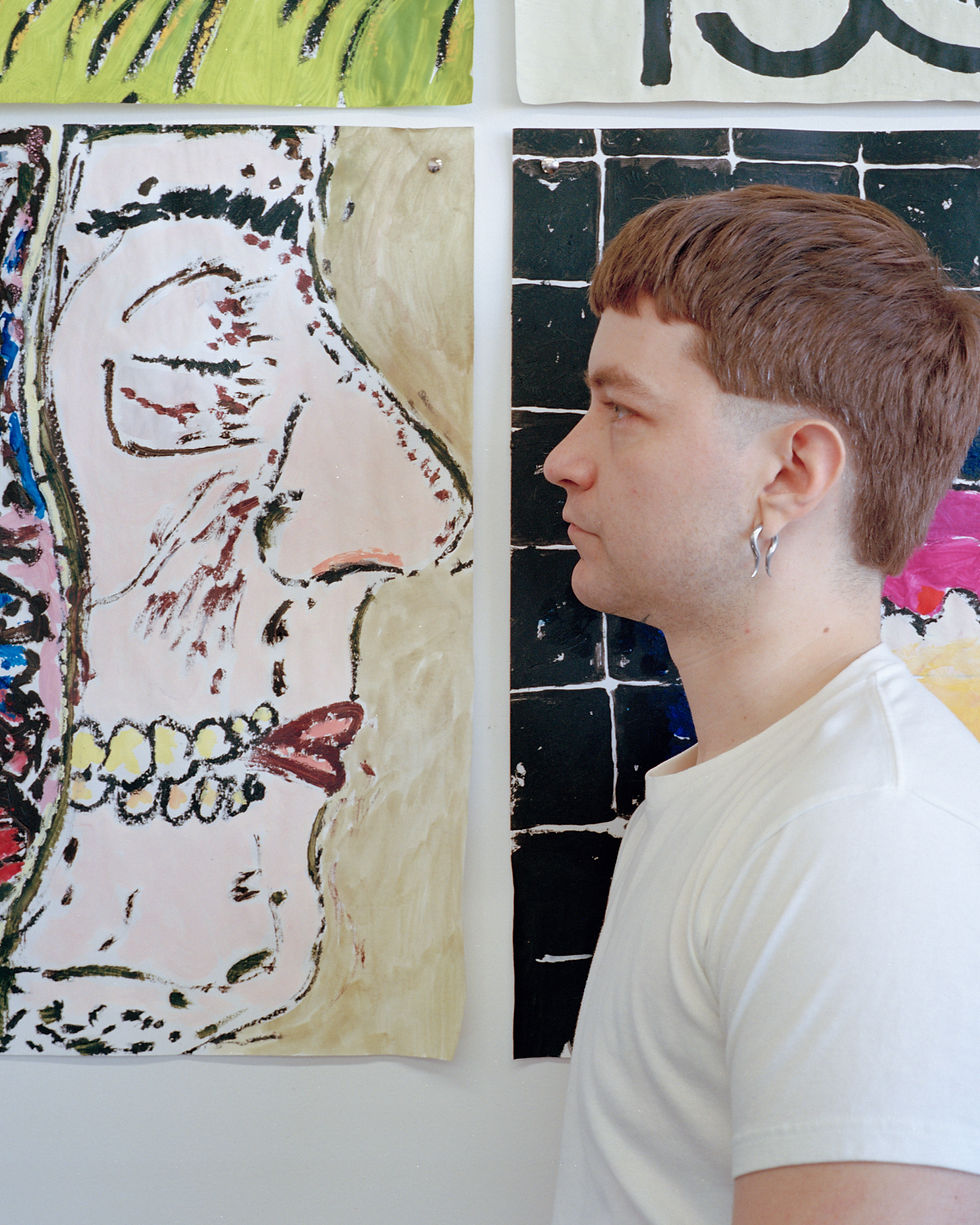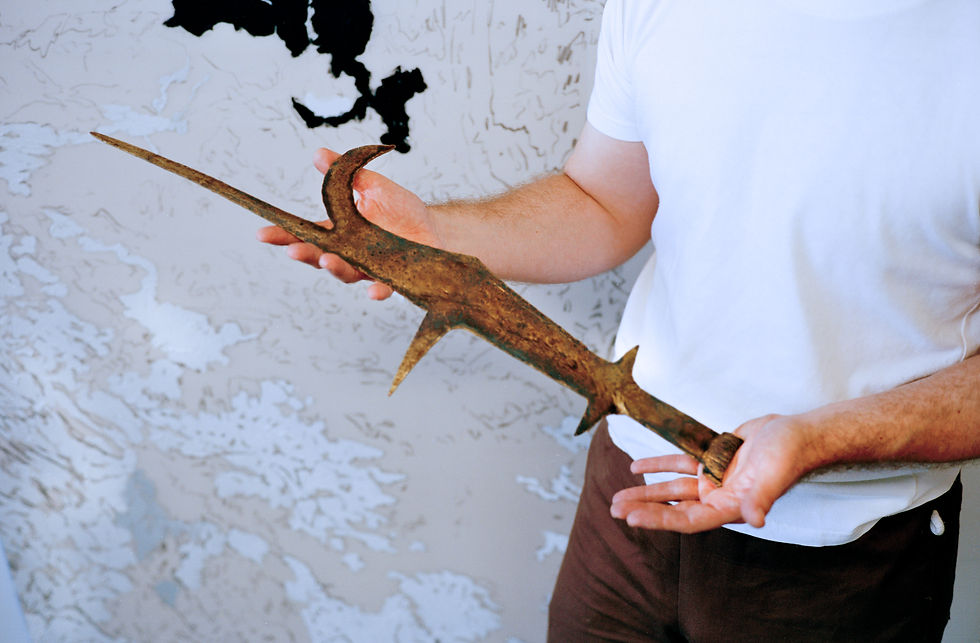Interview with Artist Dominick Smith
- TheColumbusite

- Aug 18
- 7 min read
Written by Edy Richardson
Photos by Trevor Munch
It's autumn in New York. My phone has died. I’ve gotten on the “right” subway train, but it’s going the wrong direction. I am “remaining calm,” but I can’t help feeling like the country mouse that came to town. Fortunately, the smartwatch I got just before the trip, which I barely know how to use, has cellular service, and my old friend, Dominick Smith, is calling it. Dom gives me easy directions on getting turned back around toward his art studio in Bushwick, and I make it there in one piece.

I can’t help but see the parallels between this moment and us at 19, when he’d call me and have to talk me through some part of Columbus I’d never been to before to pick him up or to see if I was at the door of the CSU Corn Center yet so he could let me in to hang out while he worked. Walking around the Bushwick neighborhood, the walls of buildings are covered in murals and impressive graffiti art. There are lots of interesting little shops and restaurants. I can’t help but feel like this is the exact type of place Dominick would thrive. As I approach the large warehouse, my watch rings again. He can apparently see me from the window of his studio. He instructs me past the loading dock, through a metal door, and up some stairs until I finally lay eyes on my old friend. It’s strange how familiar the scenario feels as he walks me through the halls past other artist studios to his main space. It’s full of natural light thanks to the wide window that looks down on the busy street below. Dominick is a multidisciplinary artist, so there is a lot to see—paintings of minerals that are much taller than me, airbrush work, paintings of phone book ads and familiar Columbus architecture, and metal sculptures of swords and ships that I remember from his summer as Columbus State University’s visiting artist.
Q: Can you give me a little history of your path as an artist? When did you know or decide that’s what you wanted to be?
A: I was a very shy kid—I wanted to connect and be known to others, but I was fearful and uncomfortable. I think I was always searching for something to give and a way to be of value to people. I was always somewhere else in my head. I’d be diagnosed with a learning disability in third grade. Being aloof and dreamy didn’t help with schoolwork, but it did help me see the world with curiosity.
I was also very sensitive, which could be painful. I developed strategies to manage the burden of heavy feelings—things like singing, drawing, fantasizing, and dreaming about all the ways my life could go. I didn’t know I wanted to be an artist as much as I knew I didn’t want to do something more traditional. I didn’t take art classes until college; I had planned on being a big band trumpet player.
Q: Where have you pursued arts education, and are there any moments from that time that most impacted your work?
A: I barely got into the Schwob School of Music for trumpet. I struggled with reading music at that level, so I started looking for a different path. I volunteered at the Columbus Museum for a summer and saw all those big, beautiful Robert Motherwell paintings. That fall, I took an intro to sculpture class with artist Mike McFalls and did well. He was encouraging, and I realized how much I liked discussing, researching, and making art.
I met older folks who called themselves artists. I met the artist George Goddard in what would be the last few years of his life. My mind was on fire with the prospect of making a life out of art. I took it seriously and did everything I could to make it happen. I was lucky enough to get accepted into the School of the Art Institute of Chicago for an MFA in sculpture. My time there changed my life.
I studied under the fantastic Richard Rezac, José Ferreira, and the late Barbara Degenieve. I took a class with Catherine Opie, who was visiting. There was this famous late-night critique seminar taught by curator Hamza Walker—I had never heard someone talk about what they were seeing the way Hamza did. He was hallucinatory, poetic, and generous. The class had room for maybe 20 people, but on the first day, the room would be overflowing with 50-plus artists. He’d sign them all up manually, and others would just audit. We’d start at 6 or 7 p.m. and go until midnight some nights, moving from one studio to the next. We’d drink, there would be serious disagreements, and factions would develop. Some folks had your back; others would strike the moment they smelled blood.
Q: What themes do you explore in your work?
A: Allowing curiosity to be the dominant feeling in my life helps me manage my fears and uncertainties. I developed an enduring curiosity to make sense of being alive. I have compulsively tried to make my memories, my pain and joy, my personal history, and my cultural and regional history into something that allows other people to see me—and, in turn, to see something of themselves.
Q: What are your preferred mediums?
A: I was trained as a sculptor. I always go back to the object-ness of a thing, even an image or something pictorial. I love working with sheet metals—aluminum, steel, and brass are a lot of fun. Lately, I’ve been making paintings on stretched nylon and thin, wavy paper. The nylon is special—it’s what they make parachutes from. It has an incredible structure and feel, and it doesn’t accept paint the way a primed canvas does. I like fighting with the materials a little bit. I also make my own paint using pure pigment and stone.
Q: What artists or individuals have been most influential to you?
A: The first art that seemed contemporary to me was already old news, but I didn’t know that at the time. I loved the New York School of the ’50s—it all felt so heroic and serious. Beautiful black-and-white portraits of serious people in their giant, ratty studios: Robert Motherwell, Willem de Kooning, Barnett Newman, Helen Frankenthaler, Lee Krasner.
As I progressed, I became obsessed with minimalists and minimal-adjacent artists, such as the Washington Color Field artists and sculptors like Anthony Caro, Tony Smith, Walter De Maria, and David Smith. Eventually, the art I studied became less white and male-centric. I love the work of Mel Edwards, Eva Hesse, Thaddeus Mosley, Carmen Herrera, and Elizabeth Murray. Those are just the more historic figures—I could rattle on.

Q: How do you feel growing up in Columbus impacted your work? And how has moving and visiting since then affected your view of Columbus?
A: I was raised to be proud of being Southern and working class. I was always aware of this notion of regionalism and the tension—real or imagined—between different parts of our country. I spent summers with my father’s family in rural Illinois. I think they thought of Columbus as a big city, and me as a city kid. My Georgia family saw my connection to Illinois as being Yankee and cosmopolitan.
As I got older, being Southern didn’t seem cool. The kids with the heaviest accents were cruel. I felt like an alien anyway, and being different in the South carried extra difficulties. It wasn’t until I left for Chicago that I really came to cherish my history and identity. Being Southern was slightly exotic, and people loved to talk about it. I bonded with others over loving country music and making light of our cultural differences whenever possible.
Q: Nostalgia seems to play a role in some of your work. Can you speak to that?
A: I’m a deeply sentimental person, and I think about the past a lot. Nostalgia is handy because it gives us a sense of control over what we can’t change. We’re only alive in the exact present moment, which hardly even feels like it’s happening. The future doesn’t exist, so what does that leave us with? The past!
Q: Tell me about your large paintings of microscopic views of gemstones.
A: They’re minerals! Have you seen Breaking Bad? After Walt's brother-in-law gets shot, he becomes obsessed with rock collecting. Everyone keeps calling them rocks, and he’s like, “They’re minerals!”
These are painted from thin-section photographs of metamorphic rocks. I’ve always loved working from found images. I think of using found images as a way of handing control over to something outside myself. I saw these microscopic compositions of color and was humbled by the complexity. What if the most beautiful thing you ever saw was inside a pebble in your yard?
Q: What’s your day-to-day like? Any hobbies or pets?
A: I wake up, I feed the cats, and then I go to the studio. My partner and I run a business, and every minute I'm not taking care of that, I’m working in my studio—six days a week.
Q: What are your hopes for the future of your art career?
A: Every day that I get to make something is a miracle. I hope for more opportunities to share my work with others and the health to do so with vigor and purpose.
Q: Any final thoughts about Columbus as an arts community?
A: I will always be thankful to artists who chose to make this region their home. Without their presence and example, I would not have known how much was possible for me.
As I leave Dominick’s studio, I reflect on how far he has come since our days in Columbus. His dedication to his craft, his ability to channel personal and regional history into his work, and his curiosity-driven approach to art are nothing short of inspiring. The light in his studio fades as the sun sets over Bushwick, but the energy in his space remains palpable. It is clear that his journey as an artist is far from over. Columbus may have shaped him, but his reach extends far beyond. It’s a privilege to witness an artist so fully immersed in his work, and I look forward to seeing where his creativity takes him next. ◼️




